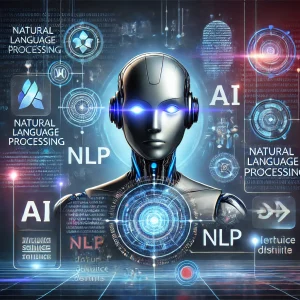In the vast and ever-evolving world of artificial intelligence (AI), one particular field stands out as both fascinating and incredibly useful: Natural Language Processing (NLP).
If you’ve ever asked Siri for the weather, had Google autocomplete your thoughts, or marveled at how AI chatbots understand your words, you’ve already witnessed NLP in action.
But what is NLP, and why is it so important in today’s AI-driven world? Whether you’re a beginner exploring machine learning or a seasoned AI developer, this guide will break down everything you need to know about natural language processing—from how it works to how it powers AI tools today.
What is NLP? (How AI Learns to Speak Human)
At its core, Natural Language Processing (NLP) is the intersection of linguistics and artificial intelligence that enables machines to understand, interpret, and generate human language. Think of it as teaching computers how to chat, write, summarize, translate, and even detect humor (though they’re still working on that last one).
NLP allows AI to process massive amounts of text and speech, extract meaning, identify patterns, and generate responses that feel natural.
But how does it work? And more importantly, how does NLP improve AI tools today? Let’s break it down.

How NLP Works: The Key Steps in Language Processing
1. Text Preprocessing: Cleaning Up the Data
Before AI can understand language, it needs to clean and organize text data. This process involves:
- Tokenization – Splitting text into words or phrases. (Example: “I love AI” → [“I”, “love”, “AI”])
- Stopword Removal – Removing common words like “the” and “is” to focus on the core meaning.
- Stemming & Lemmatization – Reducing words to their root form. (Example: “running” → “run”)
- Part-of-Speech (POS) Tagging – Identifying nouns, verbs, and adjectives.
This text preprocessing step ensures that AI processes information efficiently, leading to better AI-generated responses.
2. Understanding Language: Syntax & Semantics
Once the text is clean, NLP tools analyze its structure (syntax) and meaning (semantics):
- Syntax Analysis – AI checks sentence structure and grammar.
- Named Entity Recognition (NER) – Identifying names, places, dates, and key terms. (Example: „Apple“ the company vs. „apple“ the fruit.)
- Sentiment Analysis – Detecting emotional tone (positive, negative, neutral). (Example: „This product is amazing!“ → Positive sentiment)
This helps AI tools understand context, improving chatbots, search engines, and content recommendations.
3. AI Text Generation: Creating Human-Like Responses
After analyzing text, NLP models generate coherent and relevant responses. This is powered by:
- Machine Learning & Deep Learning Models – AI learns from vast datasets to recognize patterns.
- Transformers & Neural Networks – Advanced models like GPT-4 and BERT enhance text understanding.
- Reinforcement Learning – AI improves over time based on user feedback.
This is how NLP enables AI-powered chatbots, virtual assistants, and AI content writing tools to sound more natural and engaging.
How NLP Powers AI Tools Today
NLP is the backbone of many modern AI applications, including:
1. AI Chatbots & Virtual Assistants
> Siri, Alexa, and Google Assistant rely on NLP algorithms to process voice commands.
> AI-powered customer service chatbots use NLP for automated conversations.
2. Search Engines & SEO Optimization
> Google’s BERT algorithm improves search engine understanding of natural language queries.
> NLP helps businesses optimize content for SEO by analyzing search intent.
3. AI Writing & Content Creation
> AI tools like ChatGPT, Jasper, and Copy.ai generate blog posts, product descriptions, and marketing copy.
> NLP enables AI-powered grammar checkers like Grammarly and Hemingway Editor.
4. Sentiment Analysis & Market Research
> NLP is used to analyze social media trends, customer reviews, and brand sentiment.
> Businesses use sentiment analysis to improve customer experience.
5. Speech Recognition & Voice AI
> AI speech-to-text tools (like Otter.ai) use NLP to transcribe conversations.
> NLP powers text-to-speech (TTS) software in accessibility tools and smart assistants.
From legal AI tools summarizing case law to personalized content recommendations, NLP technology is transforming industries worldwide.

Challenges in NLP: Why AI Still Doesn’t Fully Understand Us
Despite its rapid advancements, NLP still faces significant challenges that impact its accuracy and effectiveness. One major issue is context understanding, where AI struggles with ambiguous language, such as differentiating between „bat“ as an animal or a baseball tool. Additionally, bias in AI models remains a concern, as NLP systems can unintentionally inherit prejudices from their training data, leading to skewed or unfair outputs. Another hurdle is multilingual accuracy, as AI performs better in widely spoken languages with abundant data, while less common languages suffer from poorer processing. Humor and sarcasm also pose difficulties, as AI often misinterprets tone and intent, resulting in awkward or incorrect responses. Researchers are continuously working to refine NLP models, addressing these limitations by improving contextual comprehension, reducing biases, and enhancing multilingual capabilities. The goal is to make AI-generated content more reliable, unbiased, and context-aware, pushing NLP toward more human-like and intuitive language understanding.
The Future of NLP: What’s Next?
Natural Language Processing (NLP) is leveling up fast, and the future looks like something straight out of a sci-fi movie (minus the evil robots, hopefully). Chatbots and virtual assistants are getting smoother and more intuitive—soon, they might even hold a conversation without sounding like a glorified answering machine. Real-time multilingual translation is on the horizon, so awkward Google Translate fails could become a thing of the past. AI is also starting to pick up on emotions, meaning your virtual assistant might finally understand when you’re being sarcastic (we can dream, right?). SEO is getting a boost, too, with NLP refining search engines to deliver even smarter results. And let’s not forget the push to reduce bias in AI, making systems fairer and more ethical. As NLP evolves, AI will be seamlessly woven into our daily lives, from customer service to legal tech—just hopefully not as our robot overlords
Final Thoughts

Natural Language Processing (NLP) is a game-changer in artificial intelligence, making AI-driven communication more intuitive and efficient.
From AI-powered legal insights to voice assistants and SEO-friendly AI tools, NLP is reshaping how humans and machines interact.
As AI continues to evolve, NLP will play a critical role in enhancing search engine rankings, improving content marketing, and driving AI-driven automation.
So next time your chatbot nails a joke (or completely misses it), remember—NLP is working hard behind the scenes to make AI smarter, more accurate, and more human-like.
And if AI ever perfectly understands sarcasm… well, that’s when we should start worrying.
Stay curious, stay informed, and let´s keep exploring the fascinating world of AI together.
This post was written with the help of different AI tools.
Recommended Read
Disclaimer: The links provided on this blog lead to external websites that are not under my control. I do not guarantee the accuracy, or the content of those sites. Visiting these sites is at your own discretion and risk.




